В. В. Подбельский Иллюстрации к курсу лекций по

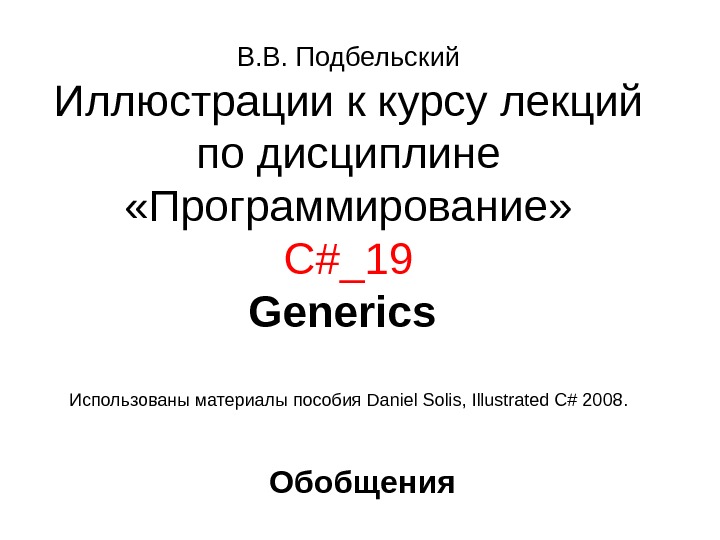
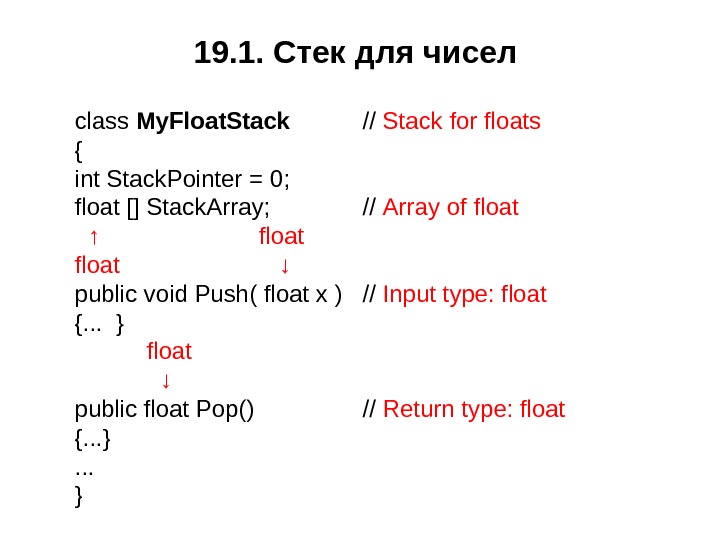
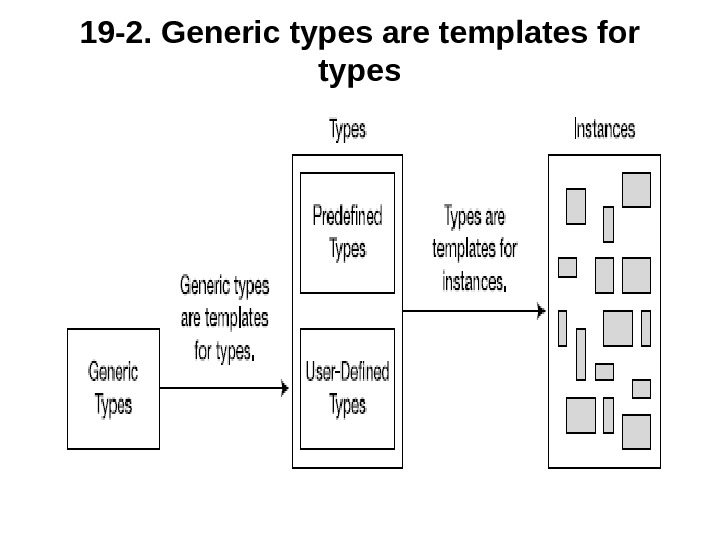
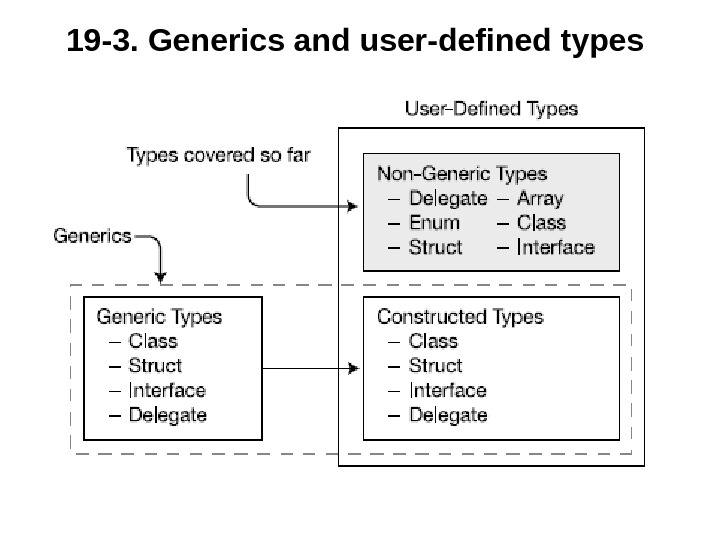

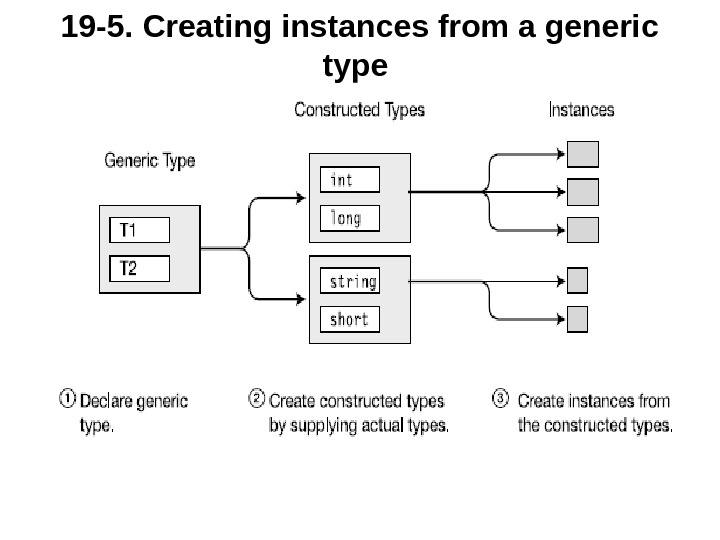
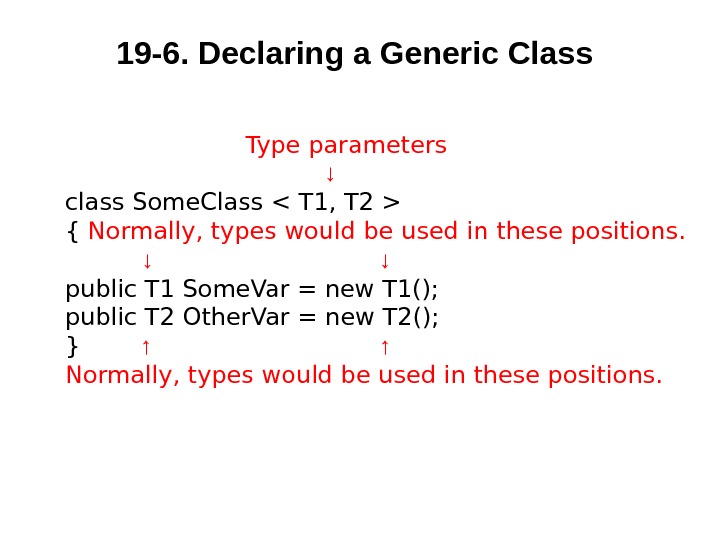



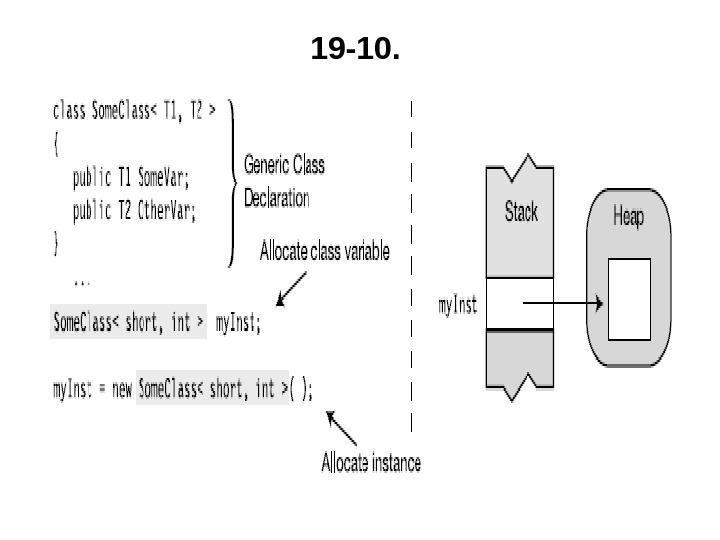

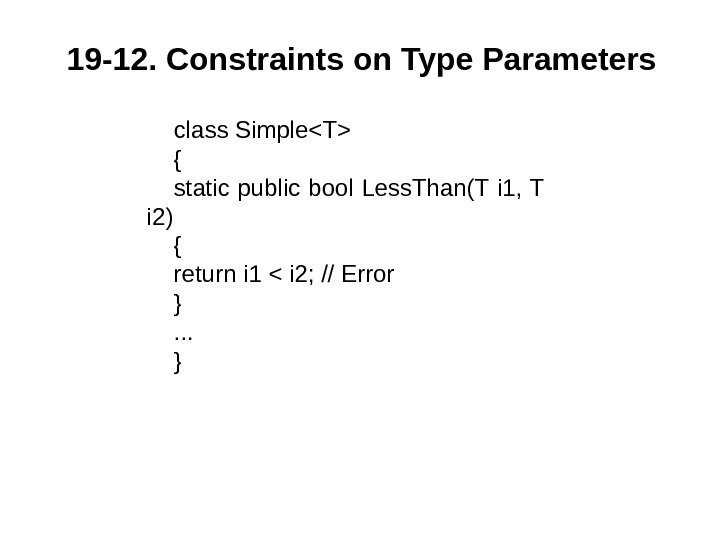

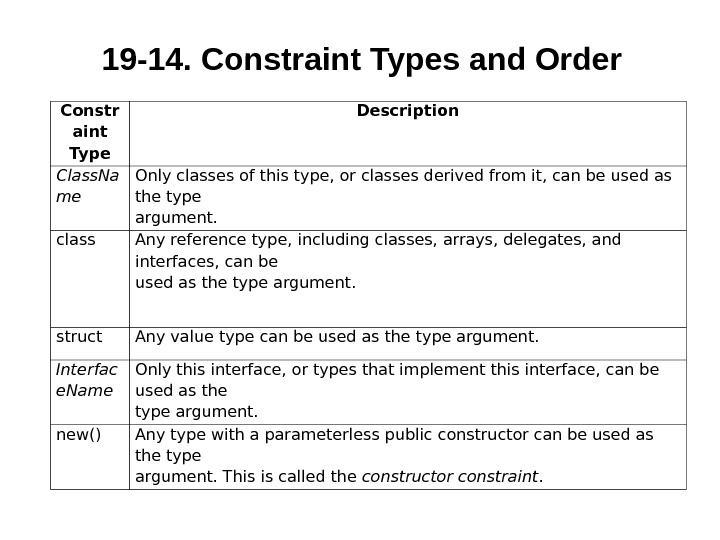
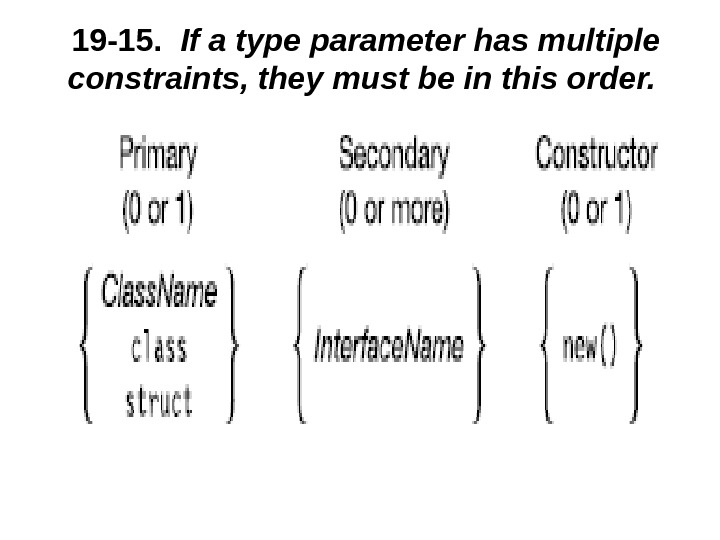
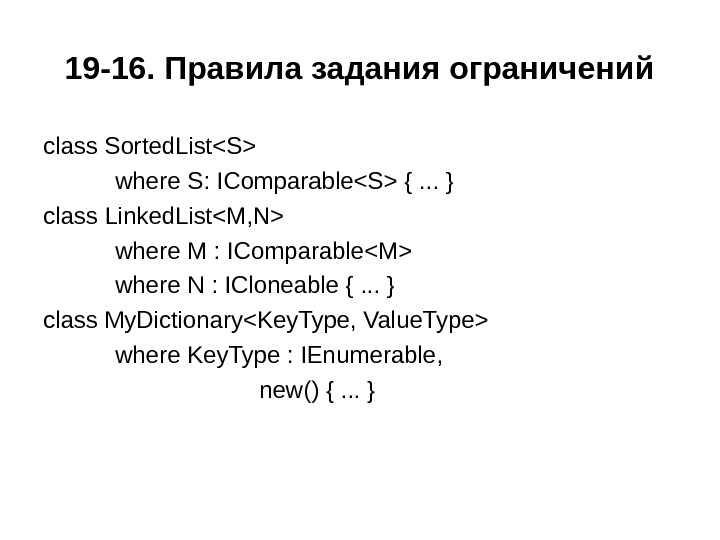
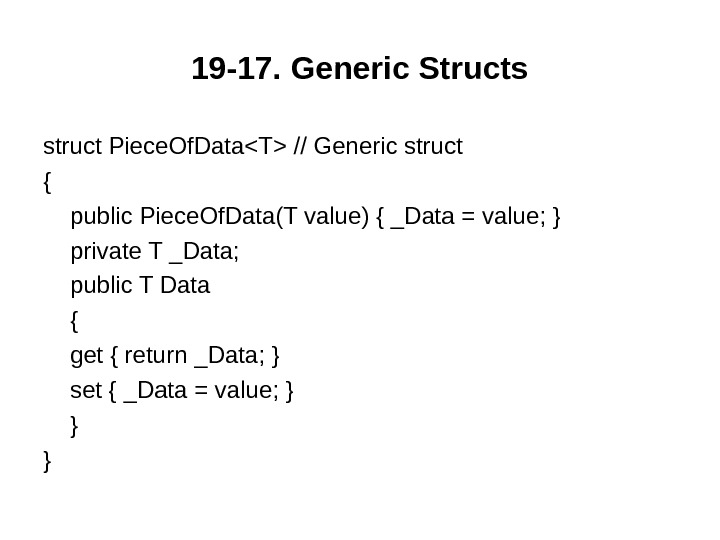
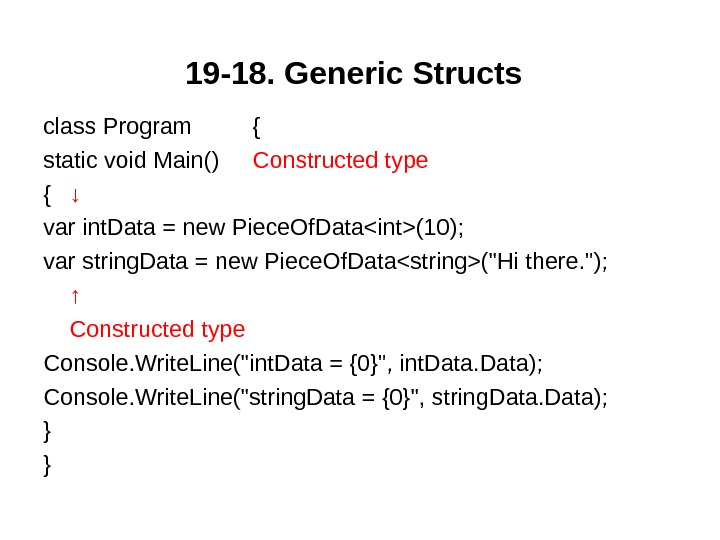
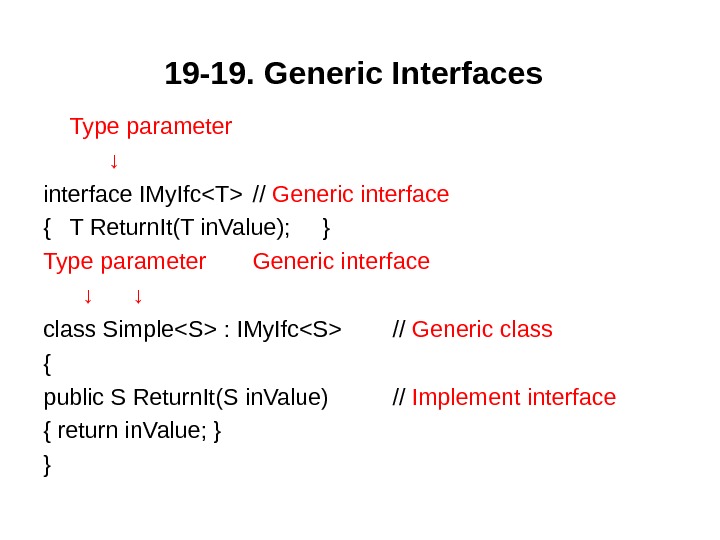
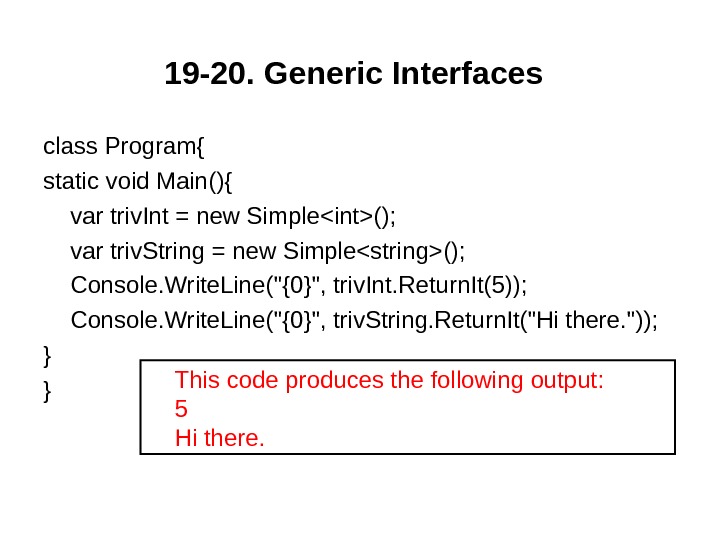
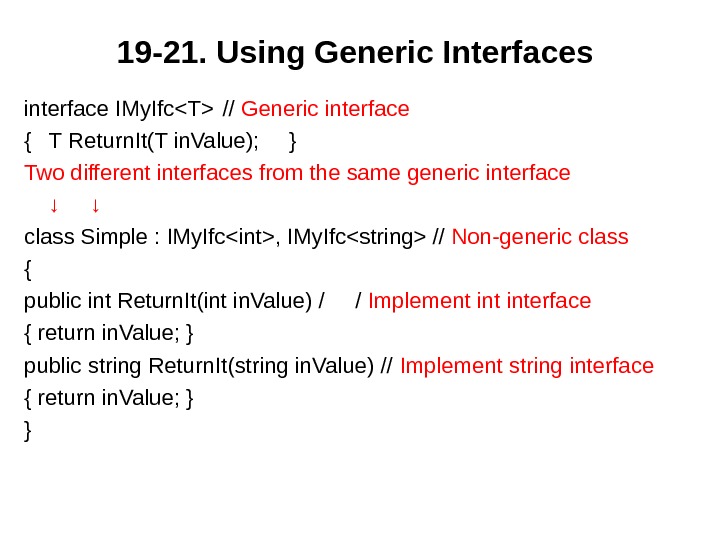
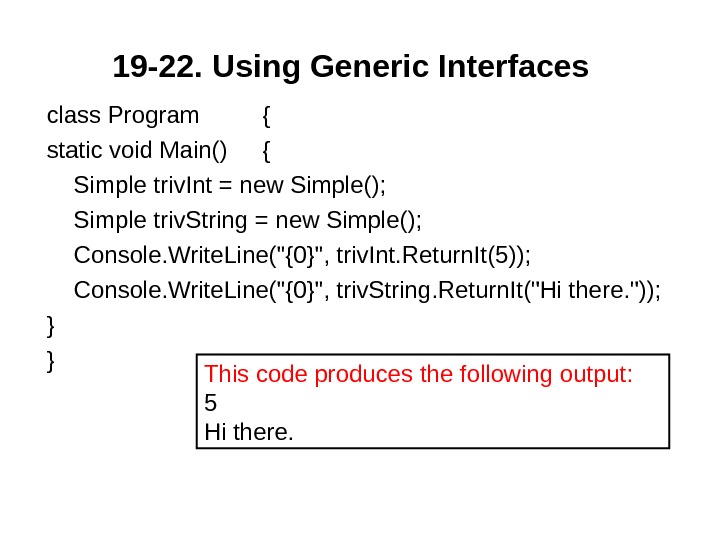
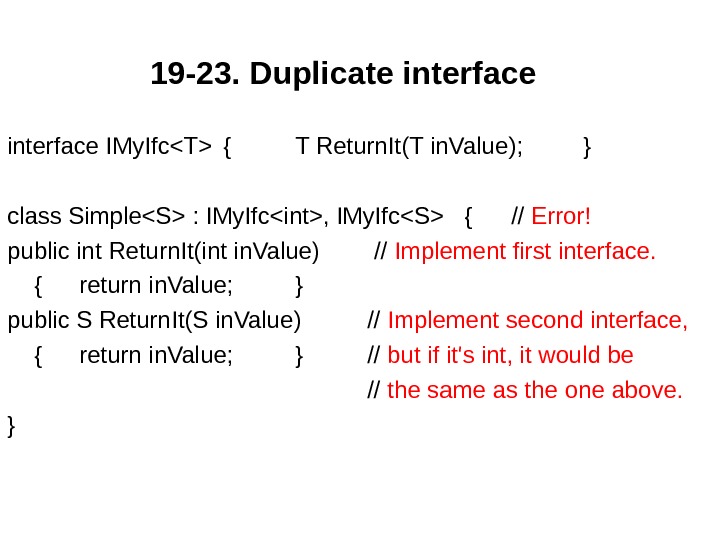
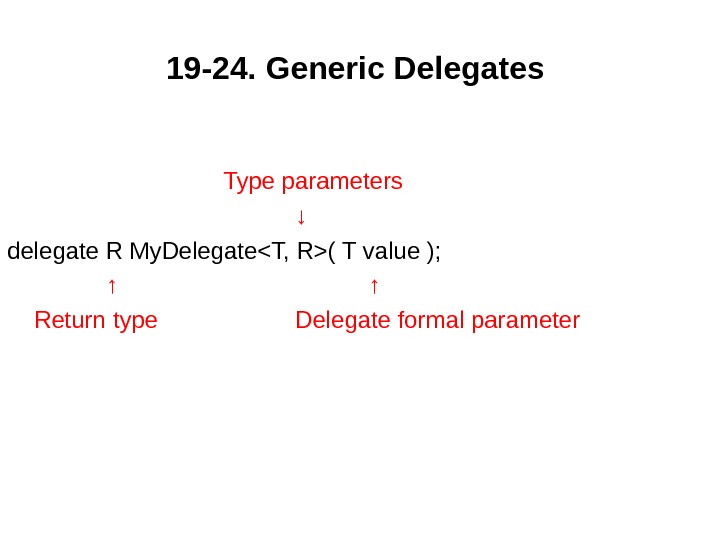
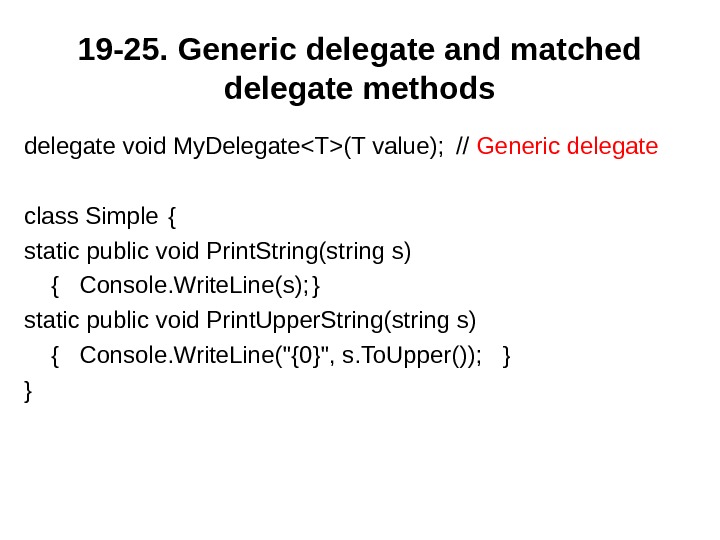
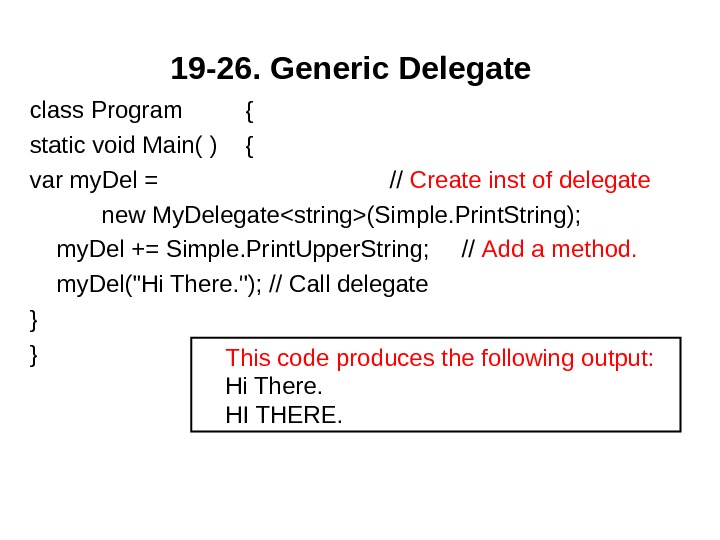
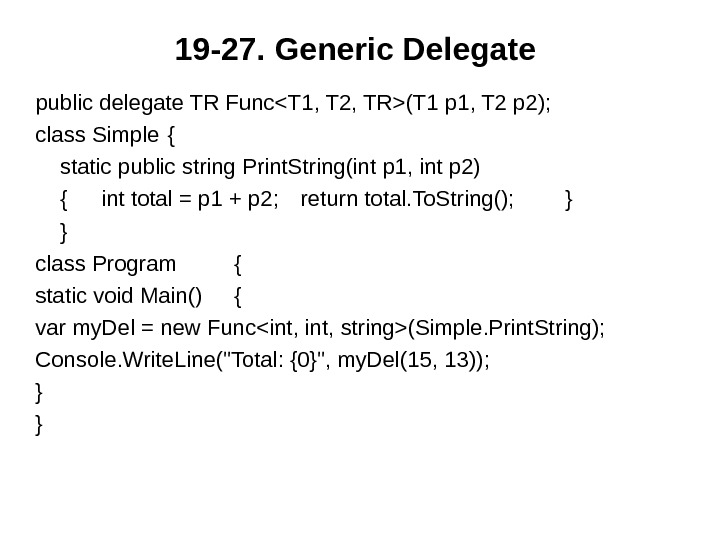
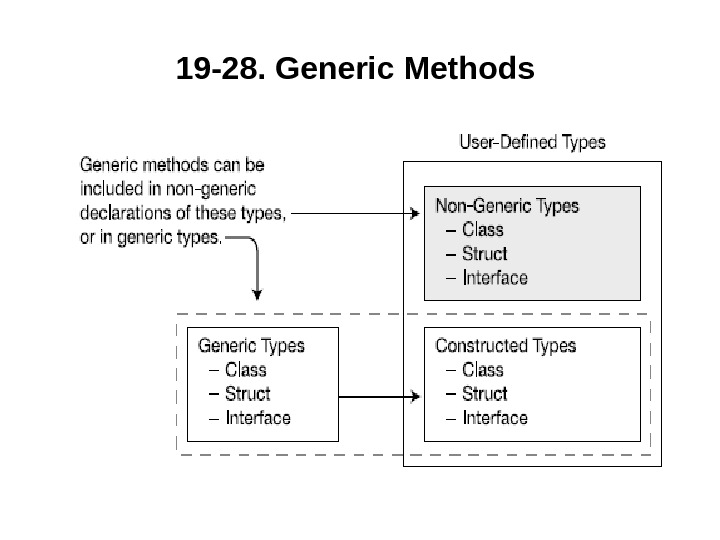
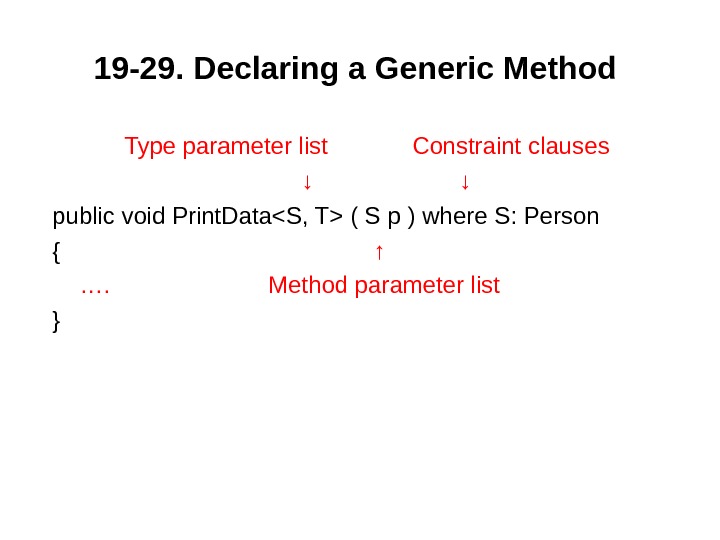
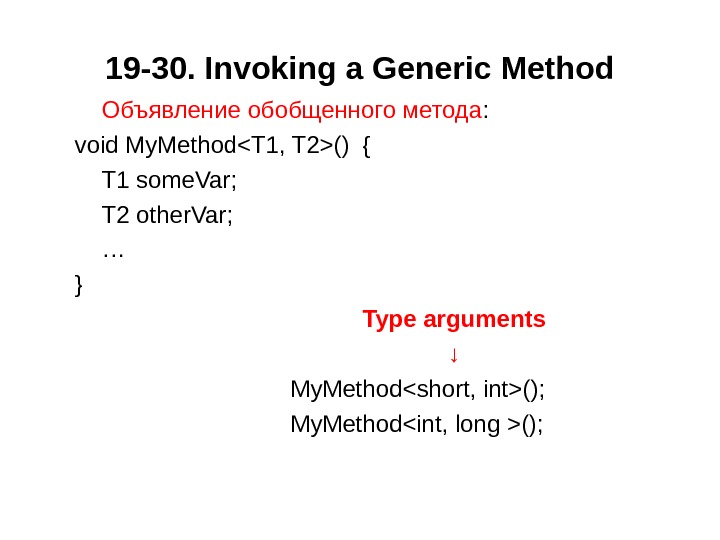
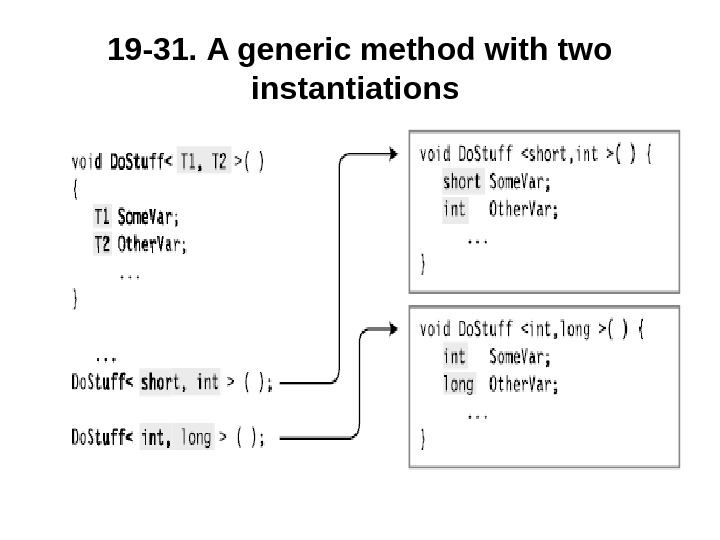
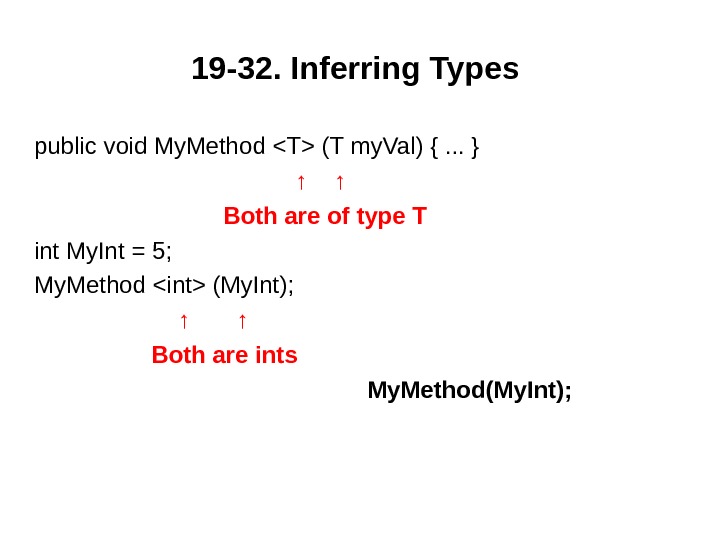
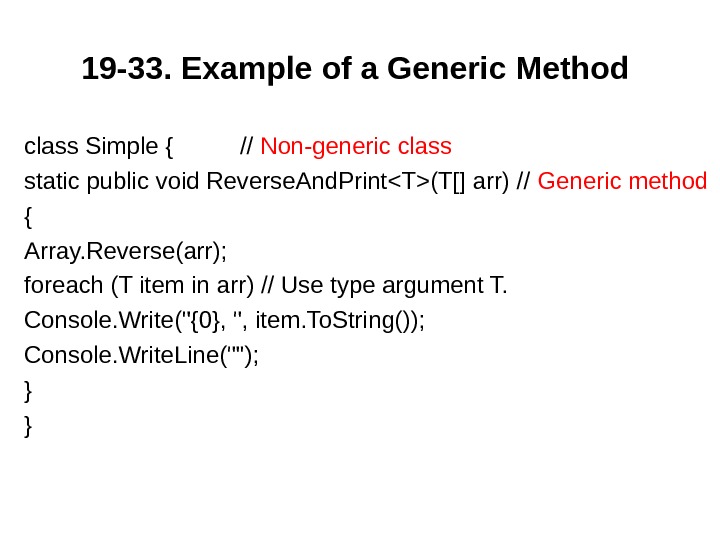
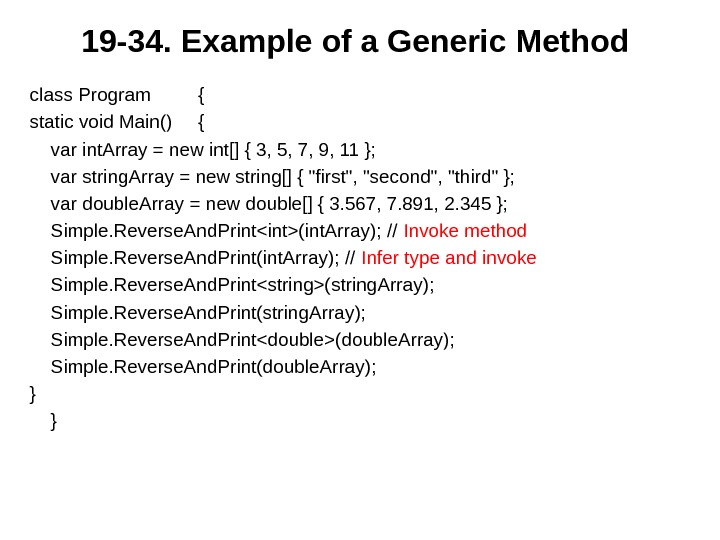

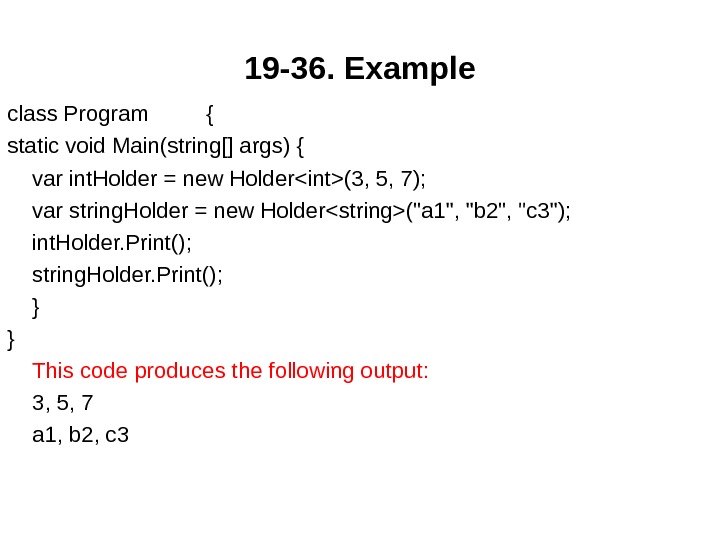

- Размер: 361 Кб
- Количество слайдов: 38
Описание презентации В. В. Подбельский Иллюстрации к курсу лекций по по слайдам
 В. В. Подбельский Иллюстрации к курсу лекций по дисциплине «Программирование» С #_ 19 Generics Использованы материалы пособия Daniel Solis, Illustrated C# 2008. Обобщения
В. В. Подбельский Иллюстрации к курсу лекций по дисциплине «Программирование» С #_ 19 Generics Использованы материалы пособия Daniel Solis, Illustrated C# 2008. Обобщения
 19. 1. Стек для чисел class My. Float. Stack // Stack for floats { int Stack. Pointer = 0; float [] Stack. Array; // Array of float ↑ float ↓ public void Push( float x ) // Input type: float {. . . } float ↓ public float Pop() // Return type: float {. . . }
19. 1. Стек для чисел class My. Float. Stack // Stack for floats { int Stack. Pointer = 0; float [] Stack. Array; // Array of float ↑ float ↓ public void Push( float x ) // Input type: float {. . . } float ↓ public float Pop() // Return type: float {. . . }
 19 -2. Generic types are templates for types
19 -2. Generic types are templates for types
 19 -3. Generics and user-defined types
19 -3. Generics and user-defined types
 19 -4. Continuing with the Stack Example class My. Stack { int Stack. Pointer = 0; T [] Stack. Array; public void Push( T x ) {. . . } public T Pop() {. . . }
19 -4. Continuing with the Stack Example class My. Stack { int Stack. Pointer = 0; T [] Stack. Array; public void Push( T x ) {. . . } public T Pop() {. . . }
 19 -5. Creating instances from a generic type
19 -5. Creating instances from a generic type
 19 -6. Declaring a Generic Class Type parameters ↓ class Some. Class { Normally, types would be used in these positions. ↓ ↓ public T 1 Some. Var = new T 1(); public T 2 Other. Var = new T 2(); } ↑ ↑ Normally, types would be used in these positions.
19 -6. Declaring a Generic Class Type parameters ↓ class Some. Class { Normally, types would be used in these positions. ↓ ↓ public T 1 Some. Var = new T 1(); public T 2 Other. Var = new T 2(); } ↑ ↑ Normally, types would be used in these positions.
 19 -7. Creating a Constructed Type
19 -7. Creating a Constructed Type
 1 9 -8. Type parameters versus type arguments
1 9 -8. Type parameters versus type arguments
 19 -9. Creating Variables and Instances My. Non. Gen. Class my. NGC = new My. Non. Gen. Class (); Constructed class ↓ ↓ Some. Class my. Sc 1 = new Some. Class(); var my. Sc 2 = new Some. Class();
19 -9. Creating Variables and Instances My. Non. Gen. Class my. NGC = new My. Non. Gen. Class (); Constructed class ↓ ↓ Some. Class my. Sc 1 = new Some. Class(); var my. Sc 2 = new Some. Class();
 19 -10.
19 -10.
 19 -11. Two constructed classes created from a generic class
19 -11. Two constructed classes created from a generic class
 19 -12. Constraints on Type Parameters class Simple { static public bool Less. Than(T i 1, T i 2) { return i 1 < i 2; // Error }. . . }
19 -12. Constraints on Type Parameters class Simple { static public bool Less. Than(T i 1, T i 2) { return i 1 < i 2; // Error }. . . }
 19 -13. Where Clauses Type parameter Constraint list ↓ ↓ where Type. Param : constraint , . . . ↑ Colon nbounded With constraints ↓ ↓ No separators class My. Class ↓ where T 2: Customer // Constraint for T 2 where T 3: Icomparable // Constraint for T 3 { ↑. . . No separators }
19 -13. Where Clauses Type parameter Constraint list ↓ ↓ where Type. Param : constraint , . . . ↑ Colon nbounded With constraints ↓ ↓ No separators class My. Class ↓ where T 2: Customer // Constraint for T 2 where T 3: Icomparable // Constraint for T 3 { ↑. . . No separators }
 19 -14. Constraint Types and Order Constr aint Type Description Class. Na me Only classes of this type, or classes derived from it, can be used as the type argument. class Any reference type, including classes, arrays, delegates, and interfaces, can be used as the type argument. struct Any value type can be used as the type argument. Interfac e. Name Only this interface, or types that implement this interface, can be used as the type argument. new() Any type with a parameterless public constructor can be used as the type argument. This is called the constructor constraint.
19 -14. Constraint Types and Order Constr aint Type Description Class. Na me Only classes of this type, or classes derived from it, can be used as the type argument. class Any reference type, including classes, arrays, delegates, and interfaces, can be used as the type argument. struct Any value type can be used as the type argument. Interfac e. Name Only this interface, or types that implement this interface, can be used as the type argument. new() Any type with a parameterless public constructor can be used as the type argument. This is called the constructor constraint.
 19 -15. If a type parameter has multiple constraints, they must be in this order.
19 -15. If a type parameter has multiple constraints, they must be in this order.
 19 -16. Правила задания ограничений class Sorted. List
19 -16. Правила задания ограничений class Sorted. List where S: IComparable {. . . } class Linked. List where M : IComparable where N : ICloneable {. . . } class My. Dictionary where Key. Type : IEnumerable, new() {. . . }
 19 -17. Generic Structs struct Piece. Of. Data // Generic struct { public Piece. Of. Data(T value) { _Data = value; } private T _Data; public T Data { get { return _Data; } set { _Data = value; } } }
19 -17. Generic Structs struct Piece. Of. Data // Generic struct { public Piece. Of. Data(T value) { _Data = value; } private T _Data; public T Data { get { return _Data; } set { _Data = value; } } }
 19 -18. Generic Structs class Program { static void Main() Constructed type { ↓ var int. Data = new Piece. Of. Data(10); var string. Data = new Piece. Of. Data(«Hi there. «); ↑ Constructed type Console. Write. Line(«int. Data = {0}», int. Data); Console. Write. Line(«string. Data = {0}», string. Data); } }
19 -18. Generic Structs class Program { static void Main() Constructed type { ↓ var int. Data = new Piece. Of. Data(10); var string. Data = new Piece. Of. Data(«Hi there. «); ↑ Constructed type Console. Write. Line(«int. Data = {0}», int. Data); Console. Write. Line(«string. Data = {0}», string. Data); } }
 19 -19. Generic Interfaces Type parameter ↓ interface IMy. Ifc // Generic interface { T Return. It(T in. Value); } Type parameter Generic interface ↓ ↓ class Simple
19 -19. Generic Interfaces Type parameter ↓ interface IMy. Ifc // Generic interface { T Return. It(T in. Value); } Type parameter Generic interface ↓ ↓ class Simple : IMy. Ifc // Generic class { public S Return. It(S in. Value) // Implement interface { return in. Value; } }
 19 -20. Generic Interfaces class Program{ static void Main(){ var triv. Int = new Simple(); var triv. String = new Simple(); Console. Write. Line(«{0}», triv. Int. Return. It(5)); Console. Write. Line(«{0}», triv. String. Return. It(«Hi there. «)); } } This code produces the following output: 5 Hi there.
19 -20. Generic Interfaces class Program{ static void Main(){ var triv. Int = new Simple(); var triv. String = new Simple(); Console. Write. Line(«{0}», triv. Int. Return. It(5)); Console. Write. Line(«{0}», triv. String. Return. It(«Hi there. «)); } } This code produces the following output: 5 Hi there.
 19 -21. Using Generic Interfaces interface IMy. Ifc // Generic interface { T Return. It(T in. Value); } Two different interfaces from the same generic interface ↓ ↓ class Simple : IMy. Ifc, IMy. Ifc // Non-generic class { public int Return. It(int in. Value) / / Implement interface { return in. Value; } public string Return. It(string in. Value) // Implement string interface { return in. Value; } }
19 -21. Using Generic Interfaces interface IMy. Ifc // Generic interface { T Return. It(T in. Value); } Two different interfaces from the same generic interface ↓ ↓ class Simple : IMy. Ifc, IMy. Ifc // Non-generic class { public int Return. It(int in. Value) / / Implement interface { return in. Value; } public string Return. It(string in. Value) // Implement string interface { return in. Value; } }
 19 -22. Using Generic Interfaces class Program { static void Main() { Simple triv. Int = new Simple(); Simple triv. String = new Simple(); Console. Write. Line(«{0}», triv. Int. Return. It(5)); Console. Write. Line(«{0}», triv. String. Return. It(«Hi there. «)); } } This code produces the following output: 5 Hi there.
19 -22. Using Generic Interfaces class Program { static void Main() { Simple triv. Int = new Simple(); Simple triv. String = new Simple(); Console. Write. Line(«{0}», triv. Int. Return. It(5)); Console. Write. Line(«{0}», triv. String. Return. It(«Hi there. «)); } } This code produces the following output: 5 Hi there.
 19 -23. Duplicate interface IMy. Ifc { T Return. It(T in. Value); } class Simple
19 -23. Duplicate interface IMy. Ifc { T Return. It(T in. Value); } class Simple : IMy. Ifc, IMy. Ifc { // Error! public int Return. It(int in. Value) // Implement first interface. { return in. Value; } public S Return. It(S in. Value) // Implement second interface, { return in. Value; } // but if it’s int, it would be // the same as the one above. }
 19 -24. Generic Delegates Type parameters ↓ delegate R My. Delegate( T value ); ↑ Return type Delegate formal parameter
19 -24. Generic Delegates Type parameters ↓ delegate R My. Delegate( T value ); ↑ Return type Delegate formal parameter
 19 -25. Generic delegate and matched delegate methods delegate void My. Delegate(T value); // Generic delegate class Simple { static public void Print. String(string s ) { Console. Write. Line(s); } static public void Print. Upper. String(string s) { Console. Write. Line(«{0}», s. To. Upper()); } }
19 -25. Generic delegate and matched delegate methods delegate void My. Delegate(T value); // Generic delegate class Simple { static public void Print. String(string s ) { Console. Write. Line(s); } static public void Print. Upper. String(string s) { Console. Write. Line(«{0}», s. To. Upper()); } }
 19 -26. Generic Delegate class Program { static void Main( ) { var my. Del = // Create inst of delegate new My. Delegate(Simple. Print. String); my. Del += Simple. Print. Upper. String; // Add a method. my. Del(«Hi There. «); // Call delegate } } This code produces the following output: Hi There. HI THERE.
19 -26. Generic Delegate class Program { static void Main( ) { var my. Del = // Create inst of delegate new My. Delegate(Simple. Print. String); my. Del += Simple. Print. Upper. String; // Add a method. my. Del(«Hi There. «); // Call delegate } } This code produces the following output: Hi There. HI THERE.
 19 -27. Generic Delegate public delegate TR Func(T 1 p 1, T 2 p 2); class Simple { static public string Print. String(int p 1, int p 2) { int total = p 1 + p 2; return total. To. String(); } } class Program { static void Main() { var my. Del = new Func(Simple. Print. String); Console. Write. Line(«Total: {0}», my. Del(15, 13)); } }
19 -27. Generic Delegate public delegate TR Func(T 1 p 1, T 2 p 2); class Simple { static public string Print. String(int p 1, int p 2) { int total = p 1 + p 2; return total. To. String(); } } class Program { static void Main() { var my. Del = new Func(Simple. Print. String); Console. Write. Line(«Total: {0}», my. Del(15, 13)); } }
 19 -2 8. Generic Methods
19 -2 8. Generic Methods
 19 -2 9. Declaring a Generic Method Type parameter list Constraint clauses ↓ ↓ public void Print. Data
19 -2 9. Declaring a Generic Method Type parameter list Constraint clauses ↓ ↓ public void Print. Data ( S p ) where S: Person { ↑ …. Method parameter list }
 19 — 30. Invoking a Generic Method Объявление обобщенного метода : void My. Method() { T 1 some. Var; T 2 other. Var; … } Type arguments ↓ My. Method(); My. Method();
19 — 30. Invoking a Generic Method Объявление обобщенного метода : void My. Method() { T 1 some. Var; T 2 other. Var; … } Type arguments ↓ My. Method(); My. Method();
 19 — 3 1. A generic method with two instantiations
19 — 3 1. A generic method with two instantiations
 19 — 3 2. Inferring Types public void My. Method (T my. Val) {. . . } ↑ ↑ Both are of type T int My. Int = 5; My. Method (My. Int); ↑ ↑ Both are ints My. Method(My. Int);
19 — 3 2. Inferring Types public void My. Method (T my. Val) {. . . } ↑ ↑ Both are of type T int My. Int = 5; My. Method (My. Int); ↑ ↑ Both are ints My. Method(My. Int);
 19 — 3 3. Example of a Generic Method class Simple { // Non-generic class static public void Reverse. And. Print(T[] arr) // Generic method { Array. Reverse(arr); foreach (T item in arr) // Use type argument T. Console. Write(«{0}, «, item. To. String()); Console. Write. Line(«»); } }
19 — 3 3. Example of a Generic Method class Simple { // Non-generic class static public void Reverse. And. Print(T[] arr) // Generic method { Array. Reverse(arr); foreach (T item in arr) // Use type argument T. Console. Write(«{0}, «, item. To. String()); Console. Write. Line(«»); } }
 19 — 3 4. Example of a Generic Method class Program { static void Main() { var int. Array = new int[] { 3, 5, 7, 9, 11 }; var string. Array = new string[] { «first», «second», «third» }; var double. Array = new double[] { 3. 567, 7. 891, 2. 345 }; Simple. Reverse. And. Print(int. Array); // Invoke method Simple. Reverse. And. Print(int. Array); // Infer type and invoke Simple. Reverse. And. Print(string. Array); Simple. Reverse. And. Print(double. Array); Simple. Reverse. And. Print(double. Array); } }
19 — 3 4. Example of a Generic Method class Program { static void Main() { var int. Array = new int[] { 3, 5, 7, 9, 11 }; var string. Array = new string[] { «first», «second», «third» }; var double. Array = new double[] { 3. 567, 7. 891, 2. 345 }; Simple. Reverse. And. Print(int. Array); // Invoke method Simple. Reverse. And. Print(int. Array); // Infer type and invoke Simple. Reverse. And. Print(string. Array); Simple. Reverse. And. Print(double. Array); Simple. Reverse. And. Print(double. Array); } }
 19 — 3 5. Extension Methods with Generic Classes static class Extend. Holder { public static void Print(this Holder h) { T[] vals = h. Get. Values(); Console. Write. Line(«{0}, \t{1}, \t{2}», vals[0], vals[1], vals[2]); } } class Holder { T[] Vals = new T[3]; public Holder(T v 0, T v 1, T v 2) { Vals[0] = v 0; Vals[1] = v 1; Vals[2] = v 2; } public T[] Get. Values() { return Vals; } }
19 — 3 5. Extension Methods with Generic Classes static class Extend. Holder { public static void Print(this Holder h) { T[] vals = h. Get. Values(); Console. Write. Line(«{0}, \t{1}, \t{2}», vals[0], vals[1], vals[2]); } } class Holder { T[] Vals = new T[3]; public Holder(T v 0, T v 1, T v 2) { Vals[0] = v 0; Vals[1] = v 1; Vals[2] = v 2; } public T[] Get. Values() { return Vals; } }
![19 - 3 6. Example class Program { static void Main(string[] args) { var int. 19 - 3 6. Example class Program { static void Main(string[] args) { var int.](/docs//generics._19_lekciya_images/generics._19_lekciya_36.jpg) 19 — 3 6. Example class Program { static void Main(string[] args) { var int. Holder = new Holder(3, 5, 7); var string. Holder = new Holder(«a 1», «b 2», «c 3»); int. Holder. Print(); string. Holder. Print(); } } This code produces the following output: 3, 5, 7 a 1, b 2, c
19 — 3 6. Example class Program { static void Main(string[] args) { var int. Holder = new Holder(3, 5, 7); var string. Holder = new Holder(«a 1», «b 2», «c 3»); int. Holder. Print(); string. Holder. Print(); } } This code produces the following output: 3, 5, 7 a 1, b 2, c
 19 — 3 7.
19 — 3 7.

